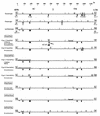Structure and distribution of endogenous nonecotropic murine leukemia viruses in wild mice
- PMID: 9733873
- PMCID: PMC110191
- DOI: 10.1128/JVI.72.10.8289-8300.1998
Structure and distribution of endogenous nonecotropic murine leukemia viruses in wild mice
Abstract
Virtually all of our present understanding of endogenous murine leukemia viruses (MLVs) is based on studies with inbred mice. To develop a better understanding of the interaction between endogenous retroviruses and their hosts, we have carried out a systematic investigation of endogenous nonecotropic MLVs in wild mice. Species studied included four major subspecies of Mus musculus (M. m. castaneus, M. m. musculus, M. m. molossinus, and M. m. domesticus) as well as four common inbred laboratory strains (AKR/J, HRS/J, C3H/HeJ, and C57BL/6J). We determined the detailed distribution of nonecotropic proviruses in the mice by using both env- and long terminal repeat (LTR)-derived oligonucleotide probes specific for the three different groups of endogenous MLVs. The analysis indicated that proviruses that react with all of the specific probes are present in most wild mouse DNAs tested, in numbers varying from 1 or 2 to more than 50. Although in common inbred laboratory strains the linkage of group-specific sequences in env and the LTR of the proviruses is strict, proviruses which combine env and the LTR sequences from different groups were commonly observed in the wild-mouse subspecies. The "recombinant" nonecotropic proviruses in the mouse genomes were amplified by PCR, and their genetic and recombinant natures were determined. These proviruses showed extended genetic variation and provide a valuable probe for study of the evolutionary relationship between MLVs and the murine hosts.
Figures







References
-
- Boeke J D, Stoye J P. Retrotransposons, endogenous retroviruses, and the evolution of retroelements. In: Coffin J M, Hughes S H, Varmus H E, editors. Retroviruses. Cold Spring Harbor, N.Y: Cold Spring Harbor Laboratory; 1997. pp. 343–435. - PubMed
-
- Ch’ang L-Y, Yank W K, Myer F E, Koh C K, Boone L R. Specific sequence deletions in two classes of murine leukemia virus-related proviruses in the mouse genome. Virology. 1989;168:245–255. - PubMed
-
- Chattopadhyay S K, Lander M R, Gupta S, Rands E, Lowy D R. Origin of mink cytopathic focus-forming (MCF) viruses: comparison with ecotropic and xenotropic murine leukemia virus genomes. Virology. 1981;113:465–483. - PubMed
Publication types
MeSH terms
Substances
Associated data
- Actions
- Actions
- Actions
- Actions
- Actions
- Actions
- Actions
- Actions
- Actions
- Actions
- Actions
- Actions
- Actions
- Actions
Grants and funding
LinkOut - more resources
Full Text Sources
Molecular Biology Databases

